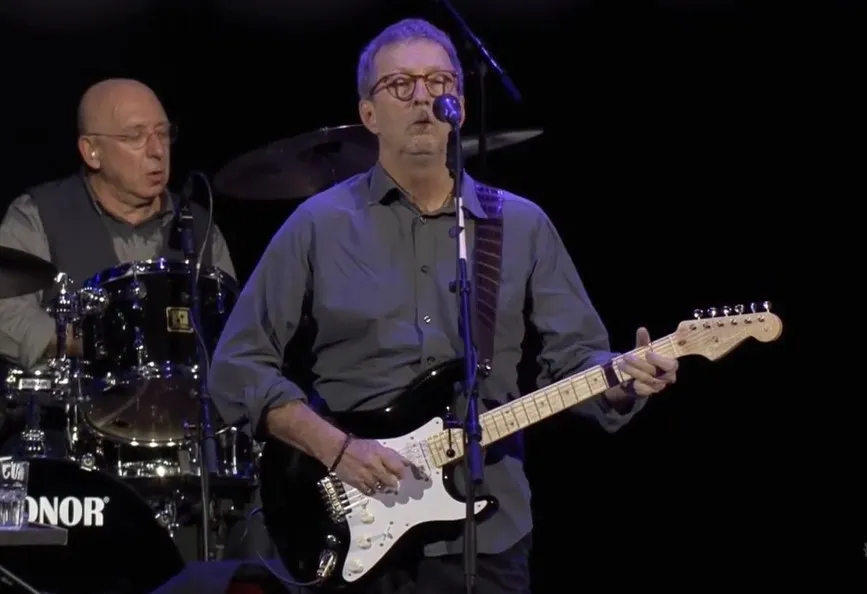About The Song
(Watch the video below)
Eric Clapton's Spellbinding Rendition of "Black Magic Woman"
While Eric Clapton isn't the original artist behind "Black Magic Woman," his 2021 rendition on the album "The Lady in the Balcony: Lockdown Sessions" holds a unique place in his discography and the song's history. This exploration delves into the origins of the song, Clapton's interpretation, and the impact it holds for both artist and audience.
"Black Magic Woman" first appeared on Fleetwood Mac's self-titled 1968 debut album. Written by guitarist Peter Green, the song blends a minor blues structure with a Latin rhythm, drawing inspiration from another Fleetwood Mac track, "I Loved Another Woman." The lyrics paint a picture of a captivating woman who holds a powerful sway over the narrator. The ambiguity surrounding "black magic" leaves room for interpretation – is it literal magic, or simply the intoxicating effect of love's hold?

The original version featured a prominent harmonica line and a driving rhythm section, showcasing the band's burgeoning blues rock sound. While it wasn't a major commercial success, peaking at number 37 on the UK Singles Chart, "Black Magic Woman" became a staple in Fleetwood Mac's live setlists, even after Green's departure.
Fast forward to 2021. The global pandemic forced the cancellation of Eric Clapton's planned shows at the Royal Albert Hall. Undeterred, Clapton gathered his band in the English countryside, seeking solace and creative expression through music. These sessions, aptly titled "The Lady in the Balcony: Lockdown Sessions," captured a raw and intimate energy, a departure from Clapton's usual studio environment.
Clapton's "Black Magic Woman" is a masterclass in reinterpretation. The bluesy foundation remains, but the song takes on a slower, more deliberate tempo. Gone is the harmonica, replaced by Clapton's signature soulful vocals and soaring guitar leads. The rhythm section lays down a deep, hypnotic groove, creating a sense of anticipation.

Clapton's guitar work is particularly noteworthy. He weaves in bluesy licks and bends, building tension throughout the song. His solos are both expressive and controlled, showcasing his masterful technique and emotional connection to the material. The interplay between his voice and guitar creates a sense of urgency and longing, perfectly capturing the song's theme of infatuation.
Clapton's "Black Magic Woman" isn't just a cover; it's a reimagining. He respects the original's spirit while injecting it with his own musical identity. The slower tempo allows him to explore the emotional depths of the lyrics, while his guitar work adds a layer of sophistication and depth. This rendition showcases Clapton's ability to breathe new life into classic songs, demonstrating his enduring love for the blues.
The "Lockdown Sessions" context adds another layer to the song's significance. Recorded during a time of isolation and uncertainty, the music pulsates with a yearning for connection and a return to normalcy. The bluesy lament of "Black Magic Woman" takes on a new resonance, reflecting the collective longing for a world filled with music and shared experiences.

Clapton's "Black Magic Woman" isn't just a tribute to Fleetwood Mac; it's a testament to the enduring power of the blues. The song's influence extends far beyond its original release, inspiring countless musicians across generations. Clapton's rendition serves as a reminder of the blues' ability to connect with audiences on a deep emotional level, regardless of time or place.
Eric Clapton's "Black Magic Woman" is more than a cover song. It's a captivating blend of respect and reinterpretation, showcasing his mastery of the blues and his ability to connect with his audience. Recorded during a unique and challenging time, the song takes on a new layer of meaning, reflecting the collective yearning for human connection. Clapton's "Black Magic Woman" stands as a testament to the enduring power of music, its ability to transport us, console us, and ultimately, bring us together.



